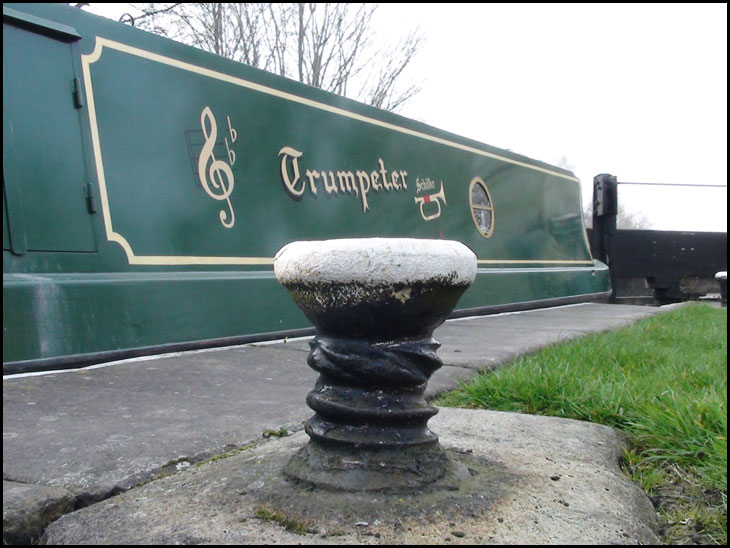Photo-a-Day (Tuesday, 8th April, 2014)
Trumpeter
Interesting photo Mick. The bollard may be worn, but what you see is a spiral or corkscrew shape to the body .
Is it not worn by the ropes over many years? I've seen similar on cannons.
it worn by the ropes over many years
Thats a lovely looking bollard if you dont mind me saying so, and yes the grooves have been worn it to it by the many years of the barge ropes use.
The barge Trumpeter is usually moored in Crooke and the owner has a trumpet and sometimes you can here him playing as you go past.
Mick; I`m somewhat surprised by the way this bollard is shaped. Why would it wear in this fashion? Perhaps Rev David could tell us.
Multiple loops of rope on the surface of a cylinder will form a helix. As the boat lowers in the lock as the water level drops, the rope is allowed to slide around the bollard helically, still keeping the boat close to the side of the lock. Once some wear is established on the bollard, rope coiled around the bollard subsequently, will naturally follow these helical wear paths thus exacerbating the situation (IMHO).
Ernest, some of the bollard is through wear, but the majority is done when casting the iron. You are an engineer Ernest, the grooves are too concentric to be wear.
The grooves are from just wear, the boatmen woudnt have time to wrap a rope a round making sure it was a engineered groove.
it worn by the ropes over many years
If that bollard is at the top end of the top lock, the heavy wear could be down to the fact that barges had to turn through 90 degrees to get in or out of the lock - so the tow rope would be exerting a massive strain on the bollard as the turn was made using it as a pivot. In docks bollards in such positions are usually of a rolling type - but in locks they are also used to stop the barge - they don't have brakes - so they have to be solid like this one.
Rev David; Have a look at:-
https://www.flickr.com/photos/75759323@N05/8631471291/
Canal Lock Rope Bollard
The metal bollard is used to fasten boats securely whilst they are in the lock. The grooves secure the rope in place to stop it slipping.
Someone's fancy, Ernest. I've done a few thousand miles on English and French canals and I've never seen a new bollard with built-in grooves. If you think about it, when a barge is going up or down in a lock the ropes need to run smoothly around the bollards - if a rope is tied securely to a bollard the barge would get hung up on it going down, and be free to surge up and down the lock when going up. The idea is to pay out or take up the ropes so that the boat stays in position as the water moves up or down - otherwise it could be pulled forward into the lock gates - or go backwards and get hung up on the lock cill.
Spirals such as the one seen here are a nuisance on a bollard - you have to keep flicking the rope to stop it jamming.
As you'd expect, in my garden I have four massive 'bits' - the name for the type of bollard with protruding bars which are fixed to the boat itself - which are off a 400 tonne French peniche. All have shallow grooves in them, and one, presumably from the bows where it was used in stopping the barge, has the start of spirals.
Its just worn away with the ropes, I looked at it again today and saw that the one next to it closest to the lock gate was just like new because it had had so much use.
Its not a bollard!
Enlighten us, please, Jemmy.
